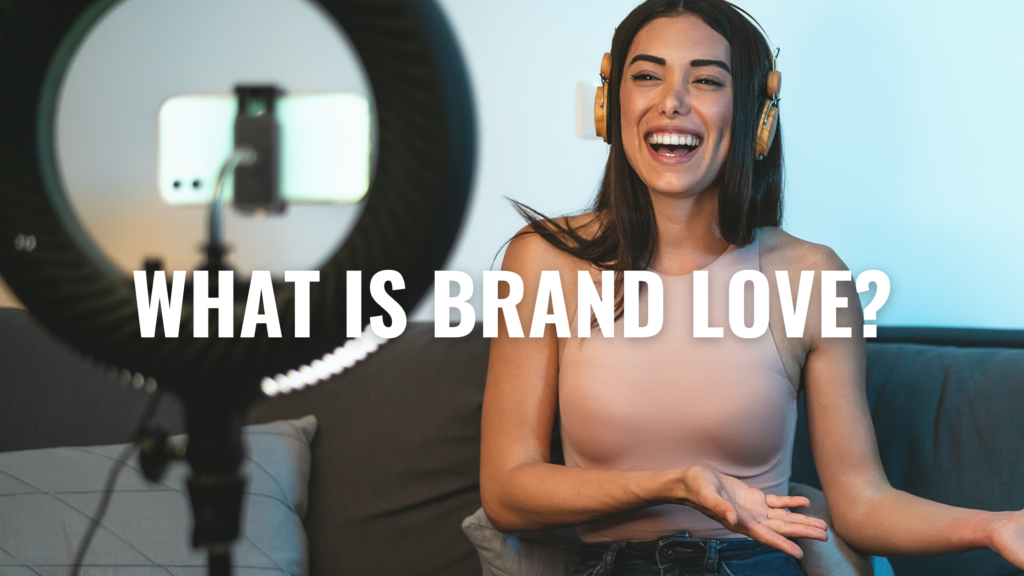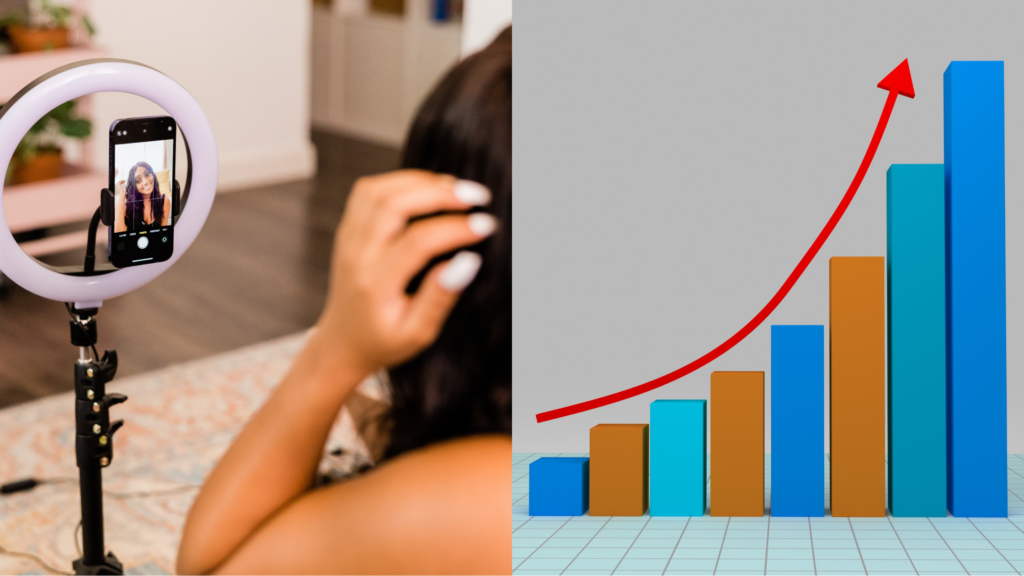The goal of marketing is always to create a strong and positive message that resonates with an audience. The ultimate goal is that consumers fall in love with the benefits of the brand and become loyal customers for years to come.
Table of Contents
- What is Brand Love?
- Brand Love & Influencer Marketing
- Measuring Brand Love & Influencer Marketing
- Influencer Marketing Strategies To Build Brand Love
- Build Relationships With Influencers
- Behind-the-Scenes Content
- User-Generated Content (UGC) Campaigns
- Experiential and Immersive Campaigns
- Cause-Driven Collaborations
- Exclusive or Early Access Collaborations
- Interactive and Engaging Formats
- Common Mistakes That Can Harm Brand Love
- Lacking Authenticity
- Inconsistent Messaging
- Not Interacting With Customers
- Neglecting Your Digital Presence
- Start Building Brand Love Today
Part of that strategy in recent years is a concept known as brand love. While that phrase can seem simple enough, the growth of social media and influencers has changed the dynamic of brand love dramatically.
This change means brands need to make sure they’re hitting on all cylinders if they want that brand love that marketers dream about.
In this guide, we’ll go over exactly what brand love is as it relates to the marketing environment in 2025. We’ll also teach you how smart influencer marketing techniques can drive brand love and position your brand in the most positive light possible.
What is Brand Love?

Brand love is the deep emotional connection that consumers develop with a brand, going beyond mere satisfaction or loyalty to a specific type of product. It reflects a passionate attachment that makes customers feel personally connected to a brand, similar to how they may feel about their favorite movie or musical artist friend. This emotional bond often leads to long-term customer advocacy, repeat purchases, and even willingness to defend or promote the brand.
In the era of social media, this makes brand love even more powerful as customers advocate for your brand without the need for incentives or motivation. Over time, this builds enormous value and provides an unbeatable ROI on the money you spend to create that emotional connection through marketing.
It’s important to distinguish between brand loyalty or product satisfaction and brand love. Brand love stems from a brand’s ability to resonate with consumers on a personal level—through shared values, exceptional experiences, or unique storytelling. Brand love is cultivated through trust, consistent positive interactions, and the ability to evoke strong emotions such as joy, nostalgia, or inspiration. Brands that successfully foster brand love often enjoy a community of dedicated followers who engage with them beyond transactions, turning their customers into brand ambassadors.
Most importantly, creating and fostering brand love is something that can be unique to each brand. That means there is almost unlimited creative freedom when it comes to designing a strategy to build your brand love.
For some, this freedom can be exciting and inspirational. However, some brands or business owners may feel lost when approaching this subject with no clear guidelines on what to do.
But don’t worry, there are a few things to keep in mind, and through the use of influencer marketing, you can start making a positive impact on your brand love.
Brand Love & Influencer Marketing
While the original concept of brand love predates social media and influencer marketing, those two things have made it more important than ever.
Social media and the rise of creators have blurred the lines between consumers, media, and brands. Today, a consumer watches content directly made by a social media creator. The consumer can ask questions or post reaction content immediately, and other consumers or the creators themselves can watch it.
This creates an entirely new dynamic around brand love and the speed and power of building this relationship is more impressive than ever before.
Smart brands are tapping into this power and influencer marketing is the key foundation for making this happen. Combined with a strong overall social media strategy, a brand can quickly start to foster brand love along with its other marketing goals.
But if brand love seems like a nebulous term, it can still be measured through known metrics that you may already be aware of. In the next section, we’ll cover how to measure brand love so you can gauge whether your efforts are paying off or if you need to adjust your strategy.
Measuring Brand Love & Influencer Marketing

Measuring brand love requires analyzing both qualitative and quantitative data to understand how deeply consumers connect with a brand. In social media marketing and influencer marketing, several key metrics can help provide insights into brand love.
Below, we’ll cover those metrics and how they play into brand love. Keep an eye on how most of these metrics are already available to you through various platforms you likely already use.
Since these are repurposed metrics, it makes it easy to start measuring your success once you start to make changes.
Engagement Metrics
- Likes, Comments, and Shares – High engagement rates suggest that followers feel emotionally connected to the brand and are eager to interact. It also shows that your content is resonating with the audience. Low engagement means something isn’t “clicking” and you’re not going to drive brand love by continuing down that road.
- Sentiment Analysis – Monitoring the tone of comments and mentions can reveal whether consumers express genuine affection, enthusiasm, or advocacy. Today, this is easier than ever using common social media listening tools. Artificial intelligence (AI) also helps to gauge sentiment by being able to read thousands of comments and summarizing the most common topics, tones, and attitudes present in the comments. This can then be easily presented in a graph or written form.
- User-Generated Content (UGC) – The volume of organic content created by users, such as posts, reaction videos, and reviews, is a strong indicator of brand love. It’s also possible to drive this metric up through challenges and other direct methods that spur the audience to engage and create their own unique content.
Influencer Advocacy Metrics
- Brand Mentions by Influencers – When influencers voluntarily mention a brand outside of sponsored content, it suggests authentic brand affinity. This can be done through product seeding or outreach to influencers to keep them informed of your latest developments.
- Engagement on Influencer Posts – If influencer collaborations generate high engagement and positive sentiment, it indicates strong emotional resonance with the audience. You’ll often see that an influencer’s content about a new product gets more engagement than the brand’s official content. This shows the power of creators and influencers when building brand love through engagement.
- Influencer Retention Rate – If influencers continue to work with a brand over time, it reflects a deeper alignment and emotional connection. Audiences feel a strong connection to influencers. When they notice a brand supports their favorite influencer so they can create new content, it creates a very positive sentiment regarding the brand.
3. Virality and Word-of-Mouth Indicators
- Share of Voice (SOV) – Measuring how frequently a brand is discussed compared to competitors shows its influence and emotional pull. This is sometimes also referred to as passionate advocacy and it indicates brand mentions without being prompted or asked to do so by the brand itself.
- Referral Traffic from Social Media – A high volume of social-driven traffic indicates that followers are eager to explore and engage further with the brand. Today, this can happen through social shopping or just traditional traffic to an external website.
- Brand-Related Hashtag Trends – The organic spread of branded hashtags or campaign-related tags suggests passionate community involvement.
4. Loyalty and Retention Metrics
- Repeat Engagement from Followers – Followers who consistently like, comment, or share posts over time demonstrate lasting brand love.
- Customer Lifetime Value (CLV) from Social Channels – Tracking how long social media-driven customers continue purchasing from a brand helps gauge emotional commitment. This can be broken down in your metrics through cross-referencing and using other data analytics measures. If you are using social shopping tools, measuring this becomes much easier and it’s one of the benefits of social shopping platforms such as TikTok or other social media apps.
- Net Promoter Score (NPS) on Social Media – Conducting polls or surveys to measure how likely users are to recommend the brand provides direct insights into brand advocacy. Some platforms like YouTube allow you to run these types of polls directly on the platform. In other cases, you may have to run these polls separately or hire a polling firm for larger initiatives.
Influencer Marketing Strategies To Build Brand Love
So far, we’ve covered what brand love is and how to go about measuring it using common social media metrics. The next step is to start building an influencer marketing strategy that specifically looks to build brand love.
In this section, we’ll go over some common ways that companies are building brand love through their social media and influencer marketing techniques.
Build Relationships With Influencers
Brands that engage influencers in long-term partnerships rather than one-off promotions benefit from sustained exposure and credibility. When influencers consistently showcase a brand’s products or values over time, their audience perceives the endorsement as more genuine, increasing trust and emotional attachment to the brand.
But beyond just trust, the audience also begins to see your brand as an ally that supports the creators the audience enjoys watching. Many people who follow specific creators watch new content as soon as it’s released. The creator’s content is similar to a new episode of their favorite streaming show. In some cases, maybe it’s what they watch during a lunch break or when having dinner.
This makes the content something they look forward to and an integral part of their lives. If they see a brand that helps support the content they love, that fosters extremely strong feelings toward the brand.
That kind of connection can’t be accomplished with just messaging. It takes an established partnership and it’s one of the reasons you see ongoing partnerships within the influencer marketing space.
The key to building long-term relationships with an influencer is to track your campaigns and see which influencers yield the best results. Those with high engagement metrics are ones to keep an eye on, even if they have a smaller audience that’s growing.
Avoid using influencers as one-off campaign tools if the relationship and partnership are solid. Moving on to a new influencer may be a missed opportunity to build a long-lasting partnership that boosts brand love.
Behind-the-Scenes Content

Giving influencers access to a brand’s internal processes—such as product development, company culture, or sustainability initiatives can help create an attachment to your brand. This transparency fosters a sense of connection and trust, making audiences feel more personally invested in the brand.
Another option for behind-the-scenes content is to create employee influencers. Employee influencers are members of your team who are passionate about the company and the products you produce. By allowing them to be brand ambassadors, they give customers an insider’s view of the brand and how products are developed.
This is also a very cost-effective way of boosting brand love since you likely already have potential influencers on your team. Another benefit is that employee influencers can help with your brand’s social media channels by producing completely original content that stands out.
Many brands struggle to come up with unique posts on social media day after day without the content becoming repetitive. Employee influencers allow for a great deal of creativity and content options that engage audiences while keeping your costs relatively low.
User-Generated Content (UGC) Campaigns
Encouraging influencers and their followers to create and share content related to a brand generates a sense of community. Contests, branded hashtags, and challenges help customers feel like active participants in the brand’s story, leading to deeper emotional engagement.
The key to UGC campaigns is to make them feel authentic and engaging. Just asking an audience to create a specific type of content often isn’t enough, unless there’s some type of reward involved.
If you’re not offering a specific reward or contest entry, then the challenge or other tactic needs to be engaging. Try to work with your influencers to decide what would work best based on their feedback. The influencer likely knows their audience well and can offer great insights into what type of UGC campaigns will resonate.
Experiential and Immersive Campaigns
Hosting exclusive events, brand trips, or interactive experiences for influencers allows them to authentically engage with a brand and share genuine excitement with their audiences. These campaigns enhance brand storytelling and create memorable associations that contribute to brand love.
This can also work well for B2B brands which often struggle to find success with influencer marketing. Many B2B-related events don’t get much mainstream coverage. That means a huge percentage of your target audience may not even hear about your participation in these events.
By partnering with an influencer to appear and cover an event, you can significantly expand your reach and capture hashtags and other communication during that time.
This positions your brand as a leader in the space that helps bring events to an audience that might otherwise not be able to stay updated or appear in person.
Cause-Driven Collaborations
Audiences are increasingly drawn to brands that align with their values. Causes can be external such as charities or they can be internal, such as how a brand sources materials or supports employees.
Partnering with influencers to promote social responsibility initiatives, sustainability efforts, or charitable campaigns strengthens emotional connections and fosters a sense of shared purpose.
This is particularly effective for fashion, beauty, and lifestyle brands. However, it’s beneficial for nearly any brand as consumers today demand more from the companies they do business with.
In some cases, your brand may already be involved with charities or causes that will resonate with your audience. Whether it’s local groups you partner with or special arrangements you have with employees to help them achieve a healthier work-life balance, it can be used to build brand love in an authentic way that resonates with consumers in your niche.
Exclusive or Early Access Collaborations
Providing influencers with early access to new products, limited-edition items, or exclusive collaborations makes followers feel they are part of something special. This sense of exclusivity enhances excitement and deepens brand affinity.
Interactive and Engaging Formats

Using interactive content such as Q&A sessions, live streams, or asking for audience participation helps brands foster direct engagement. Influencers who actively interact with their followers about a brand create a more personal and emotional connection, reinforcing brand love.
One example of this is the highly successful influencer campaign created by HireInfluence for Joah Beauty. Skincare brand Joah Beauty contacted HireInfluence and wanted to develop an influencer marketing campaign that would engage audiences and educate them about their Heal Me CICA concealer patches for blemishes.
After carefully selecting influencers that aligned perfectly with Joah’s target market, HireInfluence developed the #spotthepatch campaign. Selected influencers would wear the concealer patch and then challenge their audience if they could spot the product once applied.
The benefits of this campaign method were that it showcased the product in a real-world setting and also encouraged audience interaction directly related to the unique selling point of the product, which was how well it could be concealed after application.
The result was over 4 million views between TikTok and Instagram Reels.
This campaign is a perfect example of how brands can seamlessly engage with audiences in ways that align with the USP of the product. This creates an organic audience participation that fosters brand love and interest in the product beyond simple campaign messaging.
Common Mistakes That Can Harm Brand Love
Now that you have some methods for building brand love through influencer marketing, we want to cover some common mistakes that harm your efforts.
Many of these are based on best practices overall for social media marketing, but many brands can unknowingly make these mistakes as their strategy or social media efforts slowly veer off course.
Keeping an eye on these possible mistakes will help your brand avoid problems and keep your brand building moving forward.
Lacking Authenticity
A key driver of influencer marketing success is authenticity. Influencers have a real connection with their audience. When influencer marketing is successful, it taps into that connection.
One of the most common mistakes when looking to foster brand love is to lose sight of authenticity. It’s not always because the brand is inauthentic, it’s often simply a case of the brand losing focus of what’s important.
A perfect example is when a brand realizes they aren’t publishing enough content so they develop a strategy to increase social media posts. While this is a great first step, it’s common to let authenticity slide as the brand puts quantity over quality.
So in the end, the brand isn’t really being inauthentic, they simply lost focus when trying to achieve one goal and the expense of another goal. This type of trading between two goals isn’t ideal in marketing.
You want to focus on achieving one goal while maintaining all of your other attributes that have kept your brand successful. If one goal drags down another metric, there is a problem with the strategy.
Fixing this issue is rather simple and it involves asking yourself whether or not your strategy is harming your brand’s authenticity in any way. For example, if a brand copies a popular trend they see other brands using, it may yield short-term results. But overall, a lack of authenticity can harm brand love in the long term.
It’s a delicate balance between riding popular trends and maintaining authenticity, but keep an eye out for when your strategy might go too far in one direction.
Inconsistent Messaging
If you held a focus group and asked consumers to use one or two words to describe your brand, the ideal outcome would be for everyone in that group to use almost identical words to describe your brand.
That outcome would be the result of consistent messaging as you build brand love and brand awareness.
However, because social media is so fast and immediate, it’s easy for brands to quickly put out several different messages to consumers. One message may be all about cost savings. Another campaign may push a comedic angle or a popular challenge on a social media platform.
This can work, but you also run the risk of diluting your core message and preventing people from knowing exactly what your brand stands for. This runs counter to brand love as consumers can’t love a brand that is all over the place when it comes to messaging.
Whatever your brand’s core message is, make sure your campaigns feed into that core message and support. Even if you occasionally run a silly campaign, some aspects should still reinforce your core brand image.
Not Interacting With Customers
Most consumers expect brands to be active on social media. But activity isn’t the same as interaction. When customers post questions, comments, or other engagement activities, they expect the brand to reply back in some way.
A common mistake is to post a piece of content and then move on. This misses the early window where your most active customers interact with the content. Make sure you respond to these customers either by liking their comments or responding directly to questions.
You can’t respond to everyone, but responding during that early window when content first goes live plays a huge role in building brand love. As people consume the content later, they see that the brand responds to other users and it sends the message that the brand actively listens to its customers.
Neglecting Your Digital Presence
Not all founders and business owners are big on social media, even in today’s environment. If you are a founder of a brand that isn’t big on social media, you need to find someone who is and add them to your team.
No other marketing channel or medium provides the same avenue to build brand love as social media and influencer marketing. You can still create a successful business without these channels, but you’re severely limiting your potential.
Another common mistake related to this is to build a digital presence, and then abandon it or drastically reduce it. For example, creating social media channels and posting regularly but then stopping suddenly.
Nothing looks worse than a brand’s social media channels having inconsistent updates or when the last update was months ago. Despite the stories about content going viral and gaining millions of followers in days, most social media success is a long game.
Consistently posting engaging content over time will pay off like any investment. The key is to not give up before you reach your goal just because it seems like progress is slow.
Start Building Brand Love Today
Hopefully, the tips in this article have made you consider how powerful brand love can be and how easy it is to start building it with the tools you likely already use.
Always remember to keep a close eye on metrics as you start to implement any influence marketing strategy, including brand love boosting.
The metrics and analytics will tell you whether you’re on the right path or whether you need a course correction. If you do that, you’ll be building brand love in no time.





